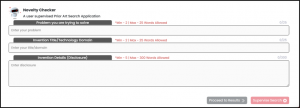
An idea’s conception is primarily an open-ended process in which innovators modify ideas depending on their ideal conceptualization. However, advancing a technology through all stages of the innovation lifecycle necessitates addressing real-world constraints. Novelty, market landscape competitiveness, future patentability, and infringement risk all limit what an idea can indeed be and whether or not it is economically feasible.
Creating a cohesive picture of these constraints in order to fit an idea to your company’s needs used to depend on the rare talents of your best innovators. Next-generation innovation now necessitates a diverse set of tools to accurately evaluate which ideas to develop. XLSCOUT combines the best of AI and human skills to ensure that the ideas you select have the best chance of being patentable and generating revenue.
IP teams can use advanced statistical modelling, data mining, and natural language processing (NLP) to move technologies forward reliably, rapidly, and systematically, working with constraints rather than against them.
Idea Novelty

Novelty is an important aspect of patentability and eventual commercial potential. But what distinguishes a novel idea? A concrete analysis of an idea’s potential to stand out technologically and commercially is required to assess its novelty. To gain commercialization perspectives, it used to take several weeks or months to compare ideas to existing patents, publications, products, and internal invention disclosures, overwhelming even the biggest and most resourceful companies.
XLSCOUT’s AI-powered analytics condense this time-consuming and costly workflow while providing reliable novelty analysis with Novelty Checker. The AI-based tool instantly provides objective insight into the uniqueness and feasibility of an idea. XLSCOUT uses reinforcement learning with its AI-based Novelty Checker to get quality patent research reports in just 5 minutes. The Novelty Checker uses reinforcement learning to filter the noise by showing the most relevant results at the top of the list. To be precise, it assists in conducting a patentability search to help you ensure that your innovation is unique. By selecting a few relevant and non-relevant results, users can apply them to the result set. The system takes the user’s feedback and then learns from it. It uses conceptual searching and re-ranks the results by bringing the quality results to the top and sending the noise to the bottom.
Infringement Risk
Novelty is only one factor that can be used to predict future patentability and competitiveness and aid in prioritizing ideas. IP teams must determine what types of protections an idea will qualify for while also assessing its commercial viability. FTO searches serve as the foundation for evaluating both patentability and the ability to utilize technology in the market while minimizing infringement risks.
FTO evaluation is difficult because competitive environments are dynamic. As a result, in order to precisely assess idea novelty and determine FTO in a wide range of markets, invention descriptions must be accurate and well-written. FTO searches are not only an important step in the idea validation process, but they can also tell you whether an idea should be pursued further or if it needs more iterations and a revised description.
By searching a broad spectrum of technical landscapes for in-force, pending, and expired patents, XLSCOUT’s FTO search streamlines infringement risk assessment workflows. Our expertise can decode patent descriptions in order to determine how dependent and independent claims may impact an idea’s potential for prioritization. Using our proprietary prior art database, XLSCOUT’s FTO searches go beyond patents to search defensive publications that can also constrain commercialization potential.
Landscape Analysis
Prioritizing ideas requires establishing idea novelty and FTO. A landscape analysis, on the other hand, will be required. Landscape analysis is critical for prioritizing ideas because it provides a comprehensive view of a market and is essential for evaluating the technological, commercial, and legal aspects of competing technologies. Commercializing and marketing an idea entail knowing who your customers and competitors are, as well as conducting a white space analysis to identify unmet needs.
Professional patent landscape analysis brings the most important data points to the surface, allowing the legal, executive, and technical teams to assess the picture as a whole. Landscape analysis also lays the groundwork for your go-to-market strategy by identifying potential M&A and licensing targets, assisting in the allocation of resources across your entire technology portfolio.

